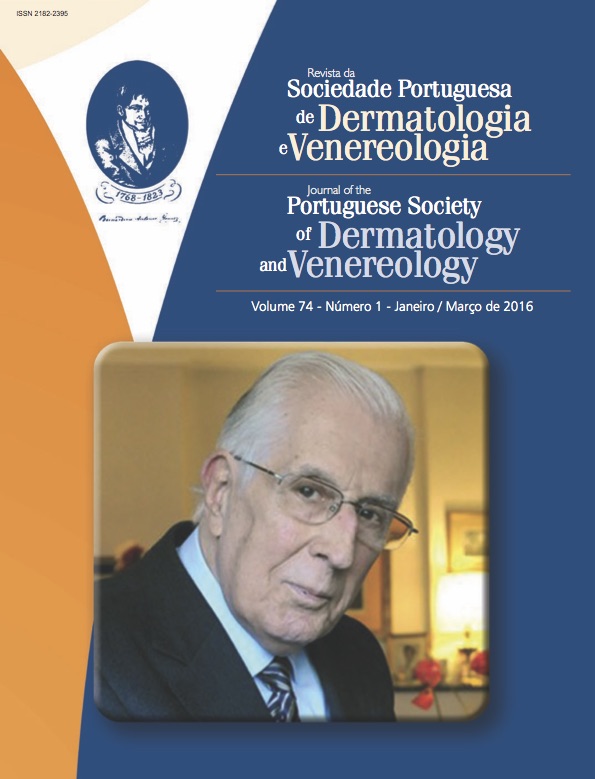Fotoquimioterapia Sistémica no Tratamento de Psoríase na Adolescência
Resumo
Introdução: A eficácia e segurança da radiação UVB no tratamento da psoríase infantil e da adolescência encontra-se bem descrita na literatura. Contudo, existem poucos dados no que concerne à utilização de psoraleno e UVA (PUVA) nesta faixa etária. O objectivo do presente trabalho é avaliar a eficácia e segurança a curto prazo da terapêutica com PUVA numa população de adolescentes com psoríase.
Métodos: Revisão e análise retrospectiva dos dados clínicos relativos aos doentes com psoríase com idade entre 13 e 17 anos. A população analisada incluiu 20 doentes, dezoito com psoríase em placas moderada a grave e dois com psoríase gutata.
Resultados: Nove doentes foram tratados com apenas um ciclo de PUVA, e os restantes com dois. Foram associadas terapêuticas sistémicas em 52%. A taxa de resposta total foi de 86,2%, com uma média global de 16,7 tratamentos de PUVA e uma dose cumulativa total média de 174,0 J/cm2. O tempo até recidiva foi de 4,3 meses, e em 2 doentes (10%) não houve recidiva durante um ano de seguimento. Observaram-se efeitos secundários em 3 doentes (15%), nomeadamente náuseas e eritema cutâneo.
Conclusões: A fotoquimioterapia demonstrou boa eficácia na nossa população de adolescentes. Os efeitos secundários foram reduzidos e não motivaram suspensão da terapêutica. O potencial carcinogénico da radiação UVA poderá ser uma limitação importante desta modalidade terapêutica, pelo que são necessários mais estudos que avaliem a sua segurança a longo prazo.
Downloads
Referências
Augustin M, Glaeske G, Radtke MA, Christophers E, Reich K, Schäfer I. Epidemiology and comorbidity of psoriasis in children. Br J Dermatol. 2010; 162:633-6.
Lara-Corrales I, Ramnarine S, Lansang P. Treatment of childhood psoriasis with phototherapy and photochemotherapy. Clin Med Insights Pediatr. 2013; 7:25-33.
Shah KN. Diagnosis and treatment of pediatric psoriasis: current and future. Am J Clin Dermatol. 2013; 14:195-213.
Pugashetti R, Koo J. Phototherapy in pediatric patients: choosing the appropriate treatment option. Semi Cutan Med Surg. 2010; 29:115-20.
Paul C, Gallini A, Archier E, Castela E, Devaux S, Aractingi S, et al. Evidence-based recommendations on topical treatment and phototherapy of psoriasis: systematic review and expert opinion of a panel of dermatologists. J Eur Acad Dermatol Venereol. 2012; 26 (Suppl 3):1-10.
Atherton DJ, Cohen BL, Knobler E, Garzon M, Morelli JG, Tay YK, et al. Phototherapy for children. Pediatr Dermatol. 1996; 13:415-26.
Pavlovsky M, Baum S, Shpiro D, Pavlovsky L, Pavlotsky F. Narrow band UVB: is it effective and safe for paediatric psoriasis and atopic dermatitis? J Eur Acad Dermatol Venereol. 2011; 25:727-9.
Tan E, Lim D, Rademaker M. Narrowband UVB phototherapy in children: A New Zealand experience. Australas J Dermatol. 2010; 51:268-73.
Zamberk P, Velázquez D, Campos M, Hernanz JM, Lázaro P. Paediatric psoriasis – narrowband UVB treatment. J Eur Acad Dermatol Venereol. 2010; 24(4):415-9.
Ersoy-Evans S, Altaykan A, Sahin S, Kölemen F. Phototherapy in childhood. Pediatr Dermatol. 2008; 25:599-605.
Jain VK, Bansal A, Aggarwal K, Jain K. Enhanced response of childhood psoriasis to narrow-band UV-B phototherapy with preirradiation use of mineral oil. Pediatric Dermatol. 2008; 25:559-64.
V, Aggarwal K, Jain K. Narrowband-UV–B phototherapy in childhood psoriasis. Int J Dermatol. 2007; 46:320-2.
Jain VK, Aggarwal K, Jain K, Bansal A. Narrow-band UV-B phototherapy in childhood psoriasis. Int J Dermatol. 2007; 46:320-2.
Jury CS, McHenry P, Burden AD, Lever R, Bilsland D. Narrow-band ultraviolet B (UVB) phototherapy in children. Clin Exp Dermatol 2006; 31:196-9.
Pasic A, Ceović R, Lipozencić J, Husar K, Susić SM, Skerlev M, et al. Phototherapy in pediatric patients. Pediatr Dermatol. 2003; 20:71-7.
Tay YK, Morelli JG, Weston WL. Experience with UVB Phototherapy in Children. Pediatr Dermatol. 1996;
:406-9.
al-Fouzan AS, Nanda A. UVB phototherapy in childhood psoriasis. Pediatr Dermatol 1995; 12:66.
de Jager ME, de Jong EM, van de Kerkhof PC, Seyger MM. Efficacy and safety of treatments for childhood psoriasis: a systematic literature review. J Am Acad Dermatol. 2010; 62(6):1013-30.
Kim MK, Ko YH, Yeo UC, Kim Y, Oh H. Psoriasis and glomerulonephritis. Clin Exp Dermatol. 1998; 23:295-6.
Braun-Falco O, Berthold D, Ruzicka T. Psoriasis pustulosa generalisata – classification, clinical aspects and therapy. Review and experiences with 18 patients. Hautarzt 1987; 38:509-20.
Archier E, Devaux S, Castela E, Gallini A, Aubin F, Le Maître M, et al. Efficacy of Psoralen UV-A therapy vs.
Narrowband UV-B therapy in chronic plaque psoriasis: a systematic literature review. J Eur Acad Dermatol Venereol. 2012; 26 (Suppl 3):11-21.
Paller A, Siegfried EC, Langley RG, Gottlieb AB, Pariser D, Landells I, et al. Etanercept treatment for children and adolescents with plaque psoriasis. N Engl J Med. 2008; 358:241-51.
Hägg D, Eriksson M, Sundström A, Schmitt-Egenolf M. The higher proportion of men with psoriasis treated with biologics may be explained by more severe disease in men. PLoS One. 2013; 15:e63619.
Eirís N, González-Lara L, Santos-Juanes J, Queiro R, Coto E, Coto-Segura P. et al. Genetic variation at IL12B,
IL23R and IL23A is associated with psoriasis severity, psoriatic arthritis and type 2 diabetes mellitus. J Dermatol
Sci. 2014; 75:167-72.
Archier E, Devaux S, Castela E, Gallini A, Aubin F, Le Maître M, et al. Carcinogenic risks of Psoralen UV-A therapy and Narrowband UV-B therapy in chronic plaque psoriasis: a systematic literature review. J Eur Acad Dermatol Venereol. 2012; 26 (Suppl 3):22-31.
Todos os artigos desta revista são de acesso aberto sob a licença internacional Creative Commons Attribution-NonCommercial 4.0 (CC BY-NC 4.0).








